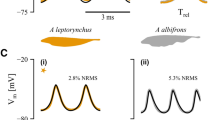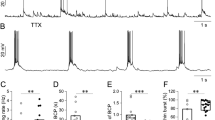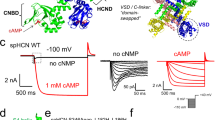Abstract
THE mechanisms underlying endogenous rhythmical electrical activity of some molluscan neurones are not completely understood. Their membranes have several significant properties: (1) rapidly inactivating Na+ and Ca2+ conductances associated with spikes1–5; (2) voltage-dependent K+ conductances (GK) (delayed1,6 and anomalous rectification3,7); and (3) a negative slope region (NSR) in the steady-state, voltage clamp current–voltage (I–V) curve8,9. Although (1) is unnecessary for bursting pacemaker potentials (BPPs)4 the relationship of (2) and (3) to the generation of BPPs has not been elucidated completely. We present here evidence that the NSR of the I–V curve is due to a voltage-dependent Na+ conductance (GNa) which inactivates incompletely and that BPPs depend on this conductance coupled to cyclical changes in GK.
This is a preview of subscription content, access via your institution
Access options
Subscribe to this journal
Receive 51 print issues and online access
$199.00 per year
only $3.90 per issue
Buy this article
- Purchase on Springer Link
- Instant access to full article PDF
Prices may be subject to local taxes which are calculated during checkout
Similar content being viewed by others
References
Alving, B. O., J. gen. Physiol., 54, 512 (1969).
Carpenter, D., and Gunn, R., J. Cell Physiol., 75, 121 (1970).
Gainer, H., Brain Res., 39, 403 (1972).
Strumwasser, F., The Physiologist, 16, 9 (1973).
Stinnakre, J., and Tauc, L., Nature new Biol., 242, 113 (1973).
Eaton, D. C., J. Physiol., Lond., 224, 421 (1972).
Faber, D. S., and Klee, M., Nature new Biol., 240, 29 (1972).
Wachtel, H., and Wilson, W. A., in Neurobiology of Invertebrates, Mechanisms of Rhythm Regulation, (edit. by Salanki, J.), 59 (Akademiai Kiado, Budapest, 1973).
David, R. J., Wilson, W. A., and Escueta, A. V., Brain Res., 67, 549 (1974).
Frazier, W. T., Kandel, E. R., Kupfermann, I., Waziri, R., and Coggeshall, R. E., J. Neurophysiol., 30, 1288 (1967).
Barker, J. L., and Gainer, H., Nature, 245, 462 (1973).
Carpenter, D. O., in Neurobiology of invertebrates: Mechanisms of Rhythm Regulations (edit. by Salanki, J.), 35 (Akademiai Kiado, Budapest, 1973).
Junge, D., and Stephens, C., J. Physiol., Lond., 235, 155 (1973).
Author information
Authors and Affiliations
Rights and permissions
About this article
Cite this article
SMITH, T., BARKER, J. & GAINER, H. Requirements for bursting pacemaker potential activity in molluscan neurones. Nature 253, 450–452 (1975). https://doi.org/10.1038/253450a0
Received:
Revised:
Issue Date:
DOI: https://doi.org/10.1038/253450a0
This article is cited by
-
Action potential bursts in central snail neurons elicited by paeonol: roles of ionic currents
Acta Pharmacologica Sinica (2010)
-
Voltage gated calcium channels in molluscs: classification, Ca2+ dependent inactivation, modulation and functional roles
Invertebrate Neuroscience (1996)
-
On the relationship between the number of negative slope regions in the voltage-current curve of the Hodgkin-Huxley model and its parameter values
Biological Cybernetics (1995)
-
Effects of applying oxytocin to Helix pomatia neurons. I. Depolarization
Neurophysiology (1988)
-
Postsynaptic mechanisms initiating bursting activity in theHelix pomatia RPal neuron under the influence of an interneuron
Neurophysiology (1987)
Comments
By submitting a comment you agree to abide by our Terms and Community Guidelines. If you find something abusive or that does not comply with our terms or guidelines please flag it as inappropriate.



